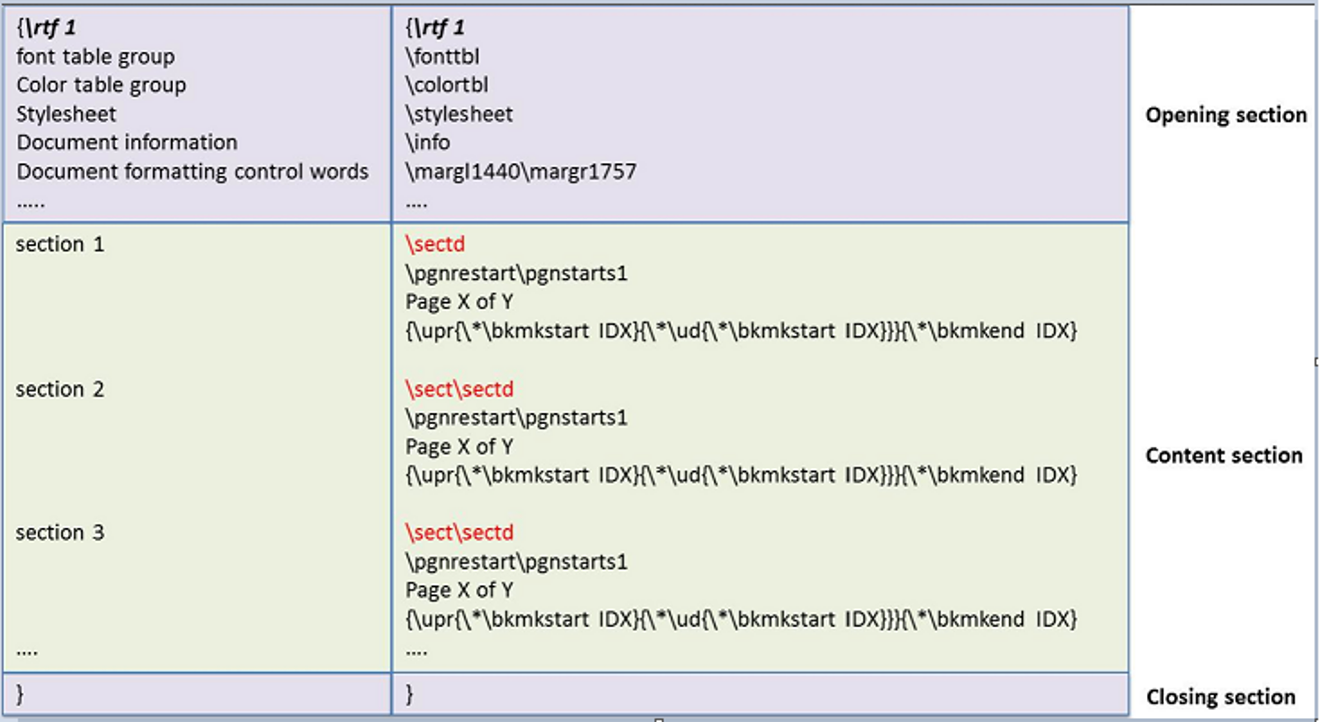This post is just a note referred from one article as shown below that I think would be beneficial for anyone who is as new as I am, as this requirement is fairly common in pharamaceutical programming.
A SAS macro to combine portrait and landscape rtf files into one single file
In order to make it suitable for every condition as follows, I will additionally perform an update so that it can be more flexible.
- containing multiple table, figure and list at the same time
- using the title as the index of table contents
- order the files manually (Just provide a solution, have not implemented yet.)
First of all, let's look at the RTF's structure, which is referred to that article.

It is divided into three parts: opening section, content section and closing section. If we look at our single rtf, that structure is still the same. Consequently, the rtf combining process can be summarized as follows:
- Read all filenames into SAS (sorted by filename or defined by manual order).
- Keep the open section of first RTF.
- Remove both opening and closing sections except the first and the last RTF. And add
\pard\sectcode in front of\sectdso that all of the files can be combined correctly. - Keep the closing section of last RTF.
- Save the updated RTF code into each SAS dataset. (Do not be saved in a single dataset, as the character length is limited in SAS.)
Now let's see the code we can use in this process. Firstly I import the rtf filenames from the external folder.
data refList(keep=filepath fn);
length fref $8 fn $80 filepath $400;
rc = filename(fref, "&inpath");
if rc = 0 then
dirid = dopen(fref);
if dirid <= 0 then
putlog 'ERR' 'OR: Unable to open directory.';
nfiles = dnum(dirid);
do i = 1 to nfiles;
fn = dread(dirid, i);
fid = mopen(dirid, fn);
if fid > 0 and index(fn,"rtf") then do;
filepath="&inpath\"||left(trim(fn));
fn = strip(tranwrd(fn,".rtf",""));
output;
end;
end;
rc = dclose(dirid);
run;Secondly, read each line in rtf file until find one line that starts with \sectd, which means the above is openning section, and below is content section. And remove the last } except the last rft file.
data rtfdt&i(where = (ptline=1));
retain ptline;
set rtfdt&i end = last;
if substr(line,1,6)='\sectd' then do;
ptline = 1;
/*enable to combine portrait and landscape rtf*/
line="\pard\sect"||compress(tranwrd(line,"\pgnrestart\pgnstarts1",""));
end;
if last and line^='}' then
line=substr(strip(line),1,length(strip(line))-1);
else if last and line='}' then delete;
run;Thirdly, when you find the title code in rtf, replace the \pard with \pard\outlinelevel1 so that this title can be identified as index for content table.
%if &titleindex = 1 %then %do;
data rtfdt&i.;
set rtfdt&i.;
retain fl 0;
if index(line,'\pard\plain\') and (not index(line,'\header\pard')) and (not index(line, '\footer\pard')) then
fl=1+fl;
run;
data rtfdt&i;
set rtfdt&i;
by fl notsorted;
if fl=1 and first.fl then /*add index for the contents as per titles*/
line=tranwrd(line,'\pard','\pard\outlinelevel1');
run;
%end;At last, don't save above rtf contents in one single SAS dataset because as the character length is limited in SAS. And add the } as the closing section so that keep the rtf file complete.
The total code as shown below:
/*Example*/
/*%s_combrtf(inpath=&inpath,outpath=&outpath,outfile=&outfile);*/
/*Parameter Description*/
/*inpath input path*/
/*outpath output path*/
/*outfile output file name*/
/*titleindex whether to add title index, default is 1*/
%macro s_combrtf(inpath= ,outpath= ,outfile= ,titleindex=1);
data refList(keep=filepath fn);
length fref $8 fn $80 filepath $400;
rc = filename(fref, "&inpath");
if rc = 0 then
dirid = dopen(fref);
if dirid <= 0 then
putlog 'ERR' 'OR: Unable to open directory.';
nfiles = dnum(dirid);
do i = 1 to nfiles;
fn = dread(dirid, i);
fid = mopen(dirid, fn);
if fid > 0 and index(fn,"rtf") then do;
filepath="&inpath\"||left(trim(fn));
fn = strip(tranwrd(fn,".rtf",""));
output;
end;
end;
rc = dclose(dirid);
run;
/*sort by filename by default*/
proc sort data = refList sortseq = linguistic(numeric_collation=on) out = sorted_refList;
by fn;
quit;
data fileorder;
set sorted_refList;
FileLevel = 2;
order = .;
run;
data _null_;
set fileorder end=last;
fnref=strip("filename fnref")||strip(_N_)||right(' "')||strip(filepath)||strip('" lrecl=5000 ;');
call execute(fnref);
if last then
call symputx('maxn',vvalue(_n_), 'l');
run;
%do i=1 %to &maxn.;
data rtfdt&i.;
infile fnref&i. truncover;
informat line $5000.;
format line $5000.;
length line $5000.;
input line $1-5000;
line=strip(line);
run;
/*add title index and adapt to more flexible*/
%if &titleindex = 1 %then %do;
data rtfdt&i.;
set rtfdt&i.;
retain fl 0;
if index(line,'\pard\plain\') and (not index(line,'\header\pard')) and (not index(line, '\footer\pard')) then
fl=1+fl;
run;
data rtfdt&i;
set rtfdt&i;
by fl notsorted;
if fl=1 and first.fl then
/*add index for the contents as per titles*/
line=tranwrd(line,'\pard','\pard\outlinelevel1');
run;
%end;
%if &i.=1 %then %do;
data final;
set rtfdt&i(keep = line) end = last;
if last and line^='}' then
line=substr(strip(line),1,length(strip(line))-1);
else if last and line='}' then delete;
run;
%end;
%if &i.^=1 %then %do;
data rtfdt&i(where = (ptline=1));
retain ptline;
set rtfdt&i end = last;
if substr(line,1,6)='\sectd' then do;
ptline = 1;
/*enable to combine portrait and landscape rtf*/
line="\pard\sect"||compress(tranwrd(line,"\pgnrestart\pgnstarts1",""));
end;
if last and line^='}' then
line=substr(strip(line),1,length(strip(line))-1);
else if last and line='}' then delete;
run;
%end;
%if &i.=&maxn. %then %do;
%local _cnt;
data final;
set final
%do _cnt=2 %to &maxn;
rtfdt&_cnt(keep = line)
%end;
;
run;
data final;
set final end = last;
if last then
line=strip(line)||strip("}");
run;
%end;
%end;
data _null_;
file "&outpath\&outfile..rtf" lrecl=5000 nopad;
set final;
put line;
run;
%mend;This appoach, in my opinion is quite excellent as it can resolve the issues as follows:
I know that different company put titles and footnotes in different places. Some may place them in header & footer section and some may place them in the body of rtf document. Above macro will works no matter how you place the titles and footnotes.
Reference
A SAS macro to combine portrait and landscape rtf files into one single file Combine multiple RTF files to one file
SM05: An Efficient Way to Combine RTF Files and Create Multi-Level Bookmarks and a Hyperlinked TOC
utl-sas-macro-to-combine-rtf-files-into-one-single-file